Wheat and Wheat Grinding 101: The Wheat {Types, Where to Buy, and What to Make}
I’ve alluded to this post/series for a while now but I’m more excited than should be deemed rational to finally be bringing you the first installment of the official Wheat and Wheat Grinding 101 series. Perhaps I’m the only one that gets giddy when talking about wheat (Huh? Weird? Me?) but alas, I do and I hope some of this information will be beneficial to those of you interested in wheat and wheat grinding.
I make no effort to hide my deep and abiding love for my wheat grinder and all the benefits it affords me and our family; namely assisting in making our own 100% whole wheat bread for the last three years. However, it took me a while to figure out the ins and outs of wheat and wheat grinding in general.
So over the next few weeks, I’ll be posting two or three more installments for Wheat 101 (including different types of wheat grinders and reviews of those, ways to use wheat and other whole grains, and a whole lot of resources).
Today, let’s talk about the main types of wheat to use in whole grain baking and cooking, the differences between them, where you can buy them and how you can use them in baking/cooking. Whether you make your own bread or not, whole wheat berries/flour can be used in many ways.
Disclaimer: I’m hitting on the wheat varieties that are common, easy to find, and that I’ve used for many years with great success. They are my preferred varieties of wheat but I have friends/family who use other types (like kamut, in particular) so feel free to do your own research on some of those wheat outliers.
Okie doke. Ready? First off, in case you didn’t know, wheat that has been hulled but unmilled (like you see below) is called wheat berries. I’ll refer to “berries” often throughout this post and didn’t want you to be looking for pictures of fresh fruit if you are new to wheat terminology.
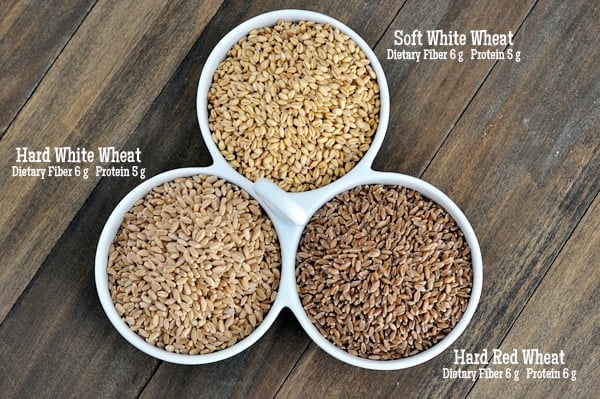
First up, let’s take a closer look at soft white wheat. The berries themselves are rounder in shape and they are lighter and more yellow in color than the other two types of wheat.
Soft white wheat, finely ground, is perfect for tender, light baked goods. Bread, rolls, and even pie crusts, pastries and cookies.
Next, we have hard red wheat. It is noticeably darker than the other two white wheat varieties. Because of it’s slightly higher protein content, it is better used for heartier, heavier breads.
It isn’t going to yield the same light color and texture in a baked good that a variety of white wheat will. Many people who try whole wheat bread with red wheat first are sometimes disappointed because it tends to produce heavy, dark loaves.
I always recommend using hard white wheat to start; for some reason, it seems easier to develop the gluten and get a lighter, more tender bread. I’m not anti-red wheat (you’ll find out more below); but it is the type of wheat that sometimes gives wheat bread in general a bad rep.
Finally, hard white wheat. Light color, just like soft white wheat, but it has a slightly longer, thinner berry shape. This is the type of wheat I use the most.
It is a great all-purpose wheat flour to use as it works great in yeasted breads/rolls and also in cookies and other baked goods.
When ground, the wheat berries produce flour at any level of coarseness or fineness, depending on your grain mill or wheat grinder. My rule of thumb, unless I’m going for a cracked wheat cereal, is to grind as finely as my grain mill allows because I like to be able to sub the wheat flour in for all-purpose flour and the more finely ground it is, the more easily I can substitute one-for-one with all-purpose flour.
I’ll be talking more in-depth about wheat grinders in a week or so, but a good rule of thumb is that one cup of wheat berries produces about 2 cups flour. Keep in mind, though, that freshly ground wheat flour is full of air from shooting out of the grinder so measuring freshly ground wheat can be a bit tricky (and is also the reason I use approximate amounts of flour for whole wheat bread recipes instead of exact measurements). I either let the flour settle for 30 minutes or so, or if I’m going to use it right away, I forget my standard flour measuring rule, and pack it in the cup a bit more to account for the airiness of just being ground.
You can see from the picture below that the ground wheat flour varies slightly in color, too, depending on the variety of wheat.
It’s hard to see it in this picture below, but the hard red wheat flour (far right) has a bit more texture and a darker color than the soft white wheat flour to the right.
I mentioned above that I prefer using hard white wheat flour. It is definitely what I use 90% of the time; however, I have about 100 pounds of hard red wheat hanging out in storage that I bought 10 years ago that I’m trying to use up, so for the last year, I’ve mixed hard red wheat and hard white wheat (grinding it together) when making bread.
And after shooting pictures for this tutorial, I made bread with all three varieties and what do you know? I think it was the best bread I’ve ever made. So, basically, experiment with the type of wheat you prefer – it will vary widely among every person.
When I lived in Northern Minnesota, I bought it from a local, organic mill near my home (I know, can you believe I moved to the middle of nowhere with an organic grain mill within 40 minutes? Awesome). They do provide shipping if you are interested in checking out their site, but I have to imagine shipping costs are pretty steep since wheat isn’t exactly feather light.
I’ve also found hard white wheat berries at:
- my local Walmart (on the very bottom shelves under the flour)
- Winco (a grocery store in my area in Idaho – they carry it in 25 pound bags)
- a local farm in Ontario, Oregon (Corn Family Farms – check around for any local farms in your area)
There are many, many online sources for wheat, but be aware that shipping costs can run high, so it might be best to check your local resources first. Here are a few online resources (I am not affiliated with any of these but have bought various products from all of them in the past with great results):
Pleasant Hill Grain (probably one of the more reasonable places to buy online)
Emergency Essentials (again, as I looked at their sales/prices, pleasantly surprised)
Shelf Reliance (more expensive but has convenient scheduled shipments, if that floats your boat, and their wheat is non-GMO)
Another resource is the LDS (Mormon) Home Storage Centers. I’m pretty sure you do not need to be a member of the LDS church to can dry goods at the Home Storage Centers (and based on several comments; that’s correct!). Here is a list of Home Storage Center locations; call for details. Their prices are extremely low, in part because you have to/get to pack it and seal it yourself either in cans or mylar bags.
Alternately, if you don’t live near a Home Storage Center, you can order #10 cans of wheat online at store.lds.org. It runs about $33 for 30 pounds of wheat (they only offer hard white or hard red wheat) and shipping is free, although you do have to live in the continental United States to order online (thanks for your comments clarifying that!).
Feel free to share any other resources you’ve found for buying wheat in the comments!
A quick note on storing wheat berries: as with most dry goods, they should be stored in a dry, cool place. My sealed cans and buckets are kept in our basement storage (wheat, if stored properly, can be kept for up to 20 years or longer!) but I keep a large 50 pound bucket in my kitchen that I fill up with the #10 cans or bags of wheat that I buy or bring up from my personal storage.
This bucket is not sealed, meaning, it won’t keep out bugs or little hands that like to let the wheat run through their chubby fingers, but I use this wheat up quickly and regularly, so as long as I keep the lid closed, I’ve never had problems with bugs (although those pesky little hands still find their way in!).
The lid is a nifty two-piece plastic ring with a lid that screws on and off. It is brilliant and saves me from prying off the original lid that came with the bucket.
These two-piece lids (sometimes called Gamma Seal Lids), meant to be used with food-grade 50# buckets, can be found online at any of the wheat resource links above (here is a link from Pleasant Hill Grain).
Now on to the good stuff.
The obvious answer is clearly to use it in breads and rolls (but scroll down for some ideas that are a bit outside of the bread box). I have dozens of yeast recipes on my site and while I haven’t specified in each and every one, it’s a given that any time I make rolls or bread, I use whole wheat flour in place of all-purpose flour.
For bread, I always use my trusted 100% whole wheat recipes. For rolls and other breads, I generally use at least half whole wheat flour, sometimes more and sometimes less (with the exception of this ciabatta bread, this rustic crusty bread and a small handful of others which I always splurge and make 100% white flour).
However, you can think outside of the box and use wheat berries in many other ways besides bread. Here are some good ones:
- Homemade Cream of Wheat Cereal: Toast the wheat berries in the oven until lightly golden, let them cool, then grind them in a grain mill or wheat grinder to the texture of hot cereal, not fine like flour but not as coarse as cracked wheat. You could probably even do that in a blender. Cook or microwave 1 cup of the toasted ground wheat berries in 3 cups water for a delicious, hot cream of wheat breakfast (this is honestly one of my boys’ favorite breakfast choices with blueberries and a touch of brown sugar and milk).
- Pancake Mix: I use 100% whole wheat flour for our favorite oatmeal pancake mix. It’s hearty, healthy and totally delish.
- Traditional Cracked Wheat: If your wheat grinder can hack it, grind the wheat berries for cracked wheat cereal.
- Whole Wheat Blender Pancakes/Waffles: This unique recipe doesn’t use flour at all; it starts with whole wheat berries that are blended with buttermilk and other ingredients. It’s another breakfast staple at our house. You can use any type of wheat berry for these.
- Wheat as a Meat Extender: You can get all wild and crazy and use wheat as a meat extender. It’s amazing! My friend Jenna told me about this years ago after she served me stroganoff that was so tasty, I asked for the recipe and she shyly admitted that the “meat” in the recipe was at least 1/2 wheat berries. WHAT? I couldn’t even tell. It’s been years since I’ve employed this method myself (I need to start again!) but I can vouch that it works. The wheat takes on the taste and texture of the meat plus it adds a whole lot of extra protein and fiber. Basically you use cooked wheat berrries (cracked wheat) and simmer it with your meat (for tacos, stroganoff and other ground beef/turkey meals that simmer or cook for a bit). Google “wheat meat extender” and you’ll get some good ideas.
Well, I think that does it for today! Next up will be a thorough look at wheat grinders. Yahoo! (Seriously, stay in your seats, people.)
Please feel free to leave any questions in the comments and I’ll get to them as soon as I can; alternatively, I’d love any suggestions about the discussion today. I have a feeling I can learn a lot from all of your experiences with wheat, too!


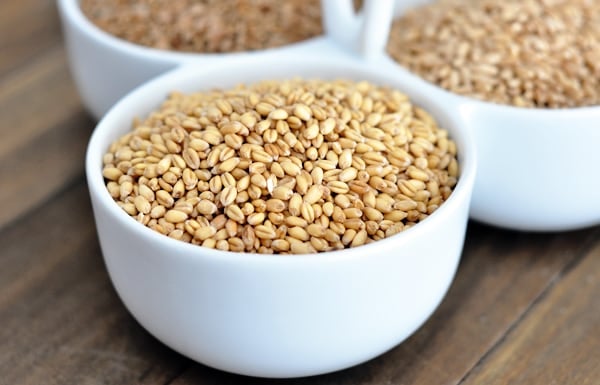
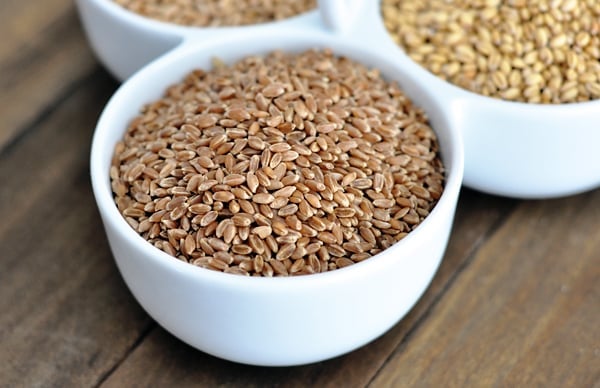
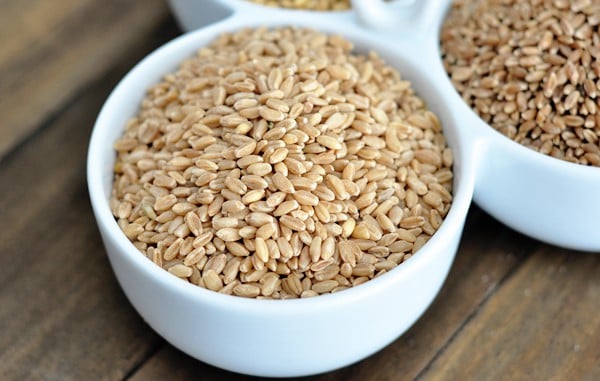
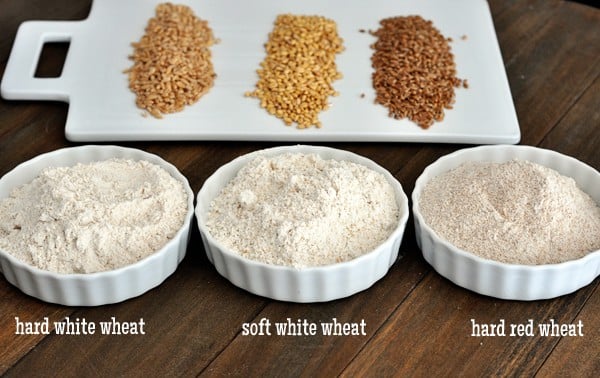
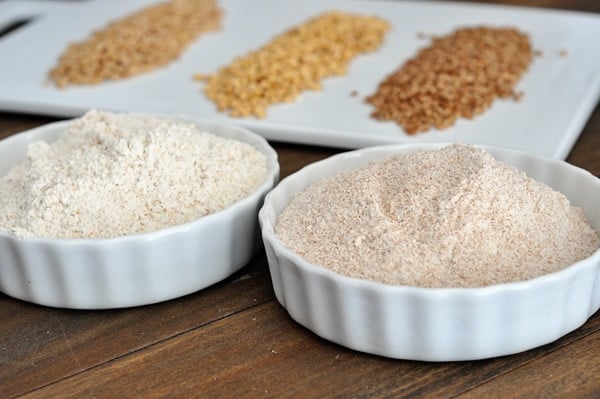

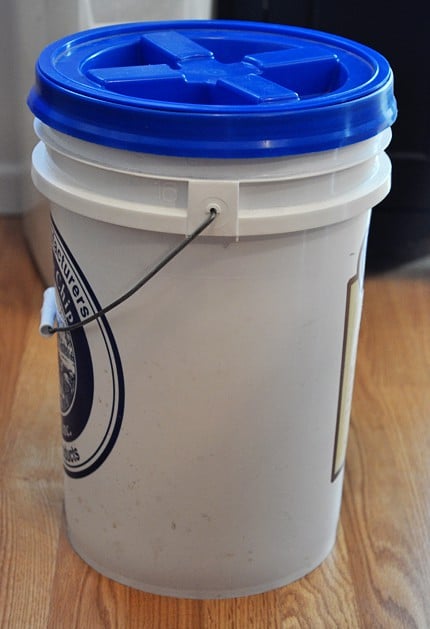
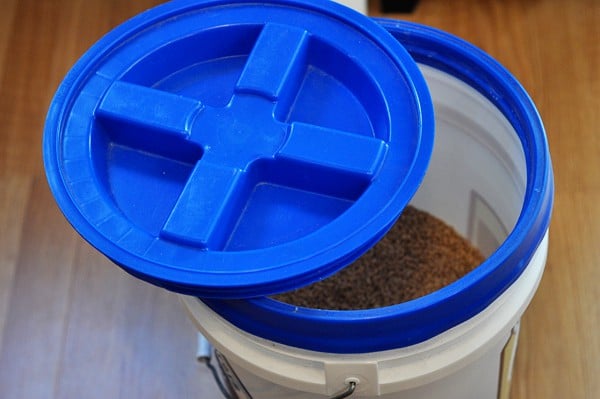
Thank you this is so interesting. I would really like to start using good flours and learn more. I have my mother-in-law west grinder and anxious to use it.
Thank you so much for the time you took providing so the valuable information.
In one section you mentioned you’ll some times make “ all white flour”
My question is, How do you make an All White Flour, in the event I want all WHITE loaf of bread?
Also I am a member of the church and being able to purchase wheat berries for our food storage is a blessing.
Thank you for your time and your expertise.
Patti Gillins
When you say “whole wheat flour” do you just mean milled flour that is not sifted? We are new to milling wheat berries. The first attempt with our Nutrimil at the finest setting made the bread really different texture and taste wise
When I use whole wheat flour I’ve ground at home, I grind the wheat berries in my wheat grinder and use like that (I don’t sift before using).
This is pretty cool! Never thought of buying and grinding my own wheat
Do you make sourdoughs with your hard white wheat grains?
I grew up in rural Colorado–and lucky enough to have an uncle who raised wheat and my dad worked at the local Co-op grain storage. Never didn’t have fresh berries in the house! And we used the waterless cookware with the great seals. My mom cooked the berries like rice-on such a low heat that you could sprout it! I loved that for cereal in the morning. Cold or hot.
Great ideas. Have been making whole wheat bread for a while now. And it is very good
I’ve been trying to get started with grinding my own flour for health’s sake. I don’t have a clue about where to buy the grains, or grinder etc… I’m thankful that I found someone that is going to be able to help people like me to know where to purchase necessary wheat berries and grinder, to begin eating our daily bread as it was intended to be in the beginning. I’m in upstate S.C. , it’s been a dead end every where I’ve searched, and tried to begin. I know fresh ground, won’t solve all of these health issues, but it certainly can’t hurt. Thank you so very much!!! Liz Redding
Hi there,
Just found your site since I’ve got two 5lb bags of wheat berries needing some grinding! I do have an attachment to do some grinding for my Kitchen Aid (Mockmill) that I’ve barely used!! I’d really like to find a nice 9grain or a cracked wheat (I love crunchy toast) (no sunflower seeds, pls.) So, not sure if you direct me to the best place to start. I’ve been baking (had done sourdough during pandemic…you know…but didn’t get on well with the math and timing!) so back to yeast.
Please let me know what grinder you use…or where to find it here. Thanks!
Thank you for writing this article. I really like king aurther’s bread flour however I just purchased a nutrill harvet grain mill and would like to mill my own flour now. Are you able to make suggestions as to which berries I should try to get something similar to King Aurthers bread flour?
It’s really hard to “make” bread flour or other white flours at home with a wheat grinder. I think you have to get other attachments for sifting and separating. But a Nutrimill is great for grinding whole wheat flours!